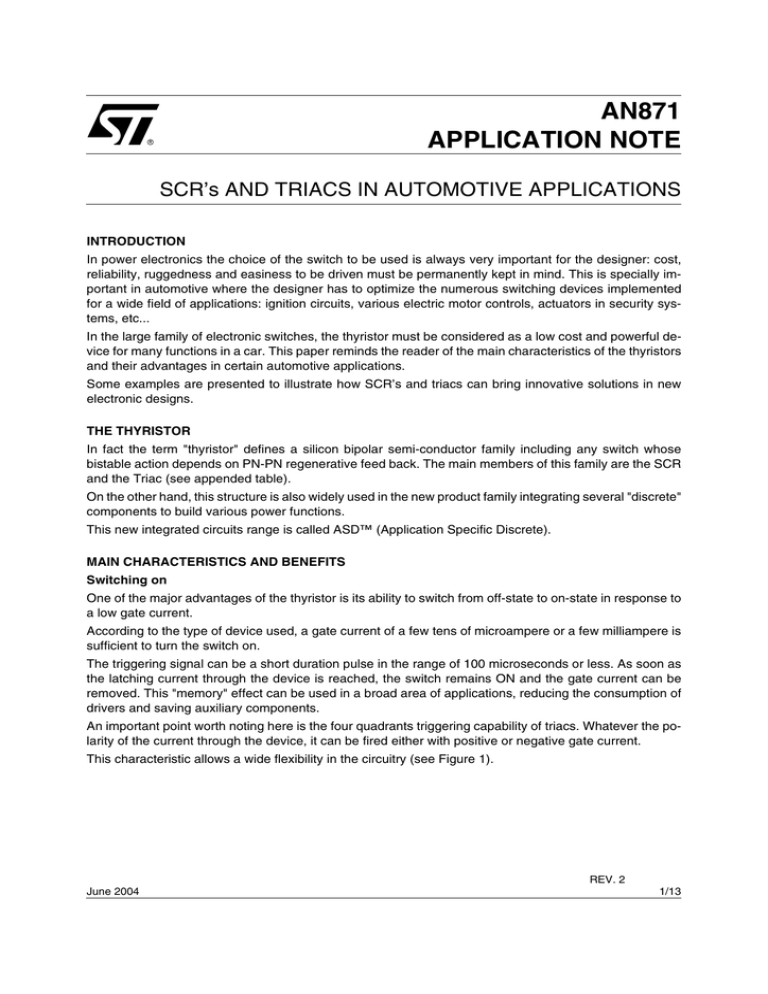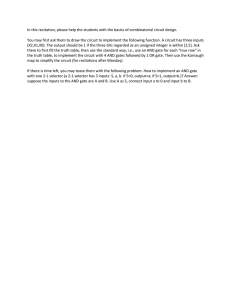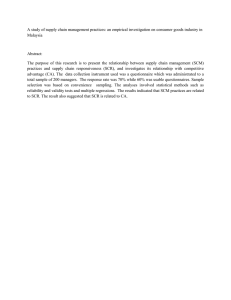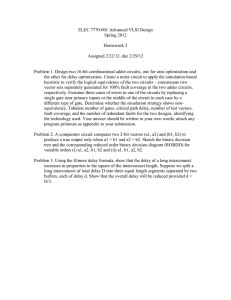
AN871
APPLICATION NOTE
SCR’s AND TRIACS IN AUTOMOTIVE APPLICATIONS
INTRODUCTION
In power electronics the choice of the switch to be used is always very important for the designer: cost,
reliability, ruggedness and easiness to be driven must be permanently kept in mind. This is specially important in automotive where the designer has to optimize the numerous switching devices implemented
for a wide field of applications: ignition circuits, various electric motor controls, actuators in security systems, etc...
In the large family of electronic switches, the thyristor must be considered as a low cost and powerful device for many functions in a car. This paper reminds the reader of the main characteristics of the thyristors
and their advantages in certain automotive applications.
Some examples are presented to illustrate how SCR’s and triacs can bring innovative solutions in new
electronic designs.
THE THYRISTOR
In fact the term "thyristor" defines a silicon bipolar semi-conductor family including any switch whose
bistable action depends on PN-PN regenerative feed back. The main members of this family are the SCR
and the Triac (see appended table).
On the other hand, this structure is also widely used in the new product family integrating several "discrete"
components to build various power functions.
This new integrated circuits range is called ASD™ (Application Specific Discrete).
MAIN CHARACTERISTICS AND BENEFITS
Switching on
One of the major advantages of the thyristor is its ability to switch from off-state to on-state in response to
a low gate current.
According to the type of device used, a gate current of a few tens of microampere or a few milliampere is
sufficient to turn the switch on.
The triggering signal can be a short duration pulse in the range of 100 microseconds or less. As soon as
the latching current through the device is reached, the switch remains ON and the gate current can be
removed. This "memory" effect can be used in a broad area of applications, reducing the consumption of
drivers and saving auxiliary components.
An important point worth noting here is the four quadrants triggering capability of triacs. Whatever the polarity of the current through the device, it can be fired either with positive or negative gate current.
This characteristic allows a wide flexibility in the circuitry (see Figure 1).
REV. 2
June 2004
1/13
AN871 APPLICATION NOTE
Figure 1. Triac triggering in the 4 quadrants
(+) A2
(+) A2
la
la
la
la
G
A1
(-) A2
(-) A2
G
A1
+lg
QUADRANT 1
G
A1
-lg
QUADRANT 2
G
A1
-lg
+lg
QUADRANT 4
QUADRANT 3
On - state
In conduction, the thyristor structure is auto saturated and the voltage drop is in the order of 1 to 2 volts
for a current density in the range of 1 to 10 A/mm2.
This switch can operate with average currents in the range of few amps in continuous mode and overall,
this on-state characteristic provides a very good behavior in high current pulse operation (see Figure 2).
Figure 2. Low voltage drop at high level of current (A) provides a high surge current capability (B)
IF (A)
Peak Current (A)
15
S= 4 mm2
S = surface of the
sicon die
10
800
S= 4 mm2
600
S= 1,5 mm2
400
5
S= 1,5 mm2
200
(A)
0
0,5
1
1,5
2
2,5
3
VF (V)
0,01
(B)
on-state current-voltage
characteristic of a thyristor
01
1
10
Duration (ms)
surge current versus duration
Switching - off
The thyristor turns off automatically when the load current decreases below the holding current level (IH)
which is generally in the range of few milliampere.
In car applications SCR and triacs are ideal for switching circuits associated with relays or any other circuit
which use a mechanical or semiconductor switch to interrupt current, and for capacity discharge circuits.
2/13
AN871 APPLICATION NOTE
Benefits
Due to these specific characteristics and properties SCR’s and triacs offer to the designer substantial benefits such as:
– Easy to drive
– Low consumption drive circuit
– Ideal switch for pulse operation (ex : discharge of capacitor)
– Automatic switching off
– Reverse polarity protection (SCR)
– Bidirectional switch - current and voltage - (triac)
– High ruggedness
EXAMPLES OF APPLICATION
Pulse operation circuits
SCR’s and triacs are really the most suitable switch for high current pulse operations. They provide very
powerful solutions especially in ignition circuits.
Ignition circuits. Used for a very long time (30 years) in small engine ignition, it is today an alternative
solution to meet the new requirements in car ignition. In fact, capacitive discharge ignition circuit provides
a higher efficiency:
– energy save
– low pollution.
The various existing configurations operate similarly: the energy stored in a capacitor is transferred to a
spark gap through a transformer and a SCR.
Figure 3 and 4 show the typical ignition circuits using SCR’s.
Figure 3. Ignition circuit with SCR: storage capacitor connected in series with input voltage source
and pulse transformer
C
+V
C
+V
(A)
(B)
3/13
AN871 APPLICATION NOTE
Figure 4. Ignition circuit with SCR: storage capacitor connected across input voltage source
+V
+V
D
D
(A)
(B)
In these circuits the diode D acts as a freewheel diode to ensure the complete discharge of the energy
stored in the capacitor C.
The current through the transformer is oscillating in the cases 3A and 4A and unidirectional in the cases
4A and 4B.
Utilization of triac
The triac can be used as a very flexible unidirectional or bidirectional switch in such a circuit.
Moreover, it can be triggered with a negative gate current. This feature allows the use of standard buffer
circuit for the gate control (see Figure 5).
4/13
AN871 APPLICATION NOTE
Figure 5. Ignition circuit with Triac: In case B the Triac is triggered by a negative gate current. In
case A, no freewheel diode is needed
+V(400V)
SPARK PLUG
Conv.
DC/DC
Vcc
DRIVER
(A)
IG
+V(400V)
(B)
SPARK PLUG
IG
DRIVER
+Vbat
Safety equipment. The discharge of capacitor is also widely used in safety equipment which sets powder
trigger mechanism in action: Air bag, belt pretensionner, etc...
In such a system, SCR’s are generally the best choice to provide high energy pulse with less than one
microsecond response time. Usually, the gate trigger drive of the SCR circuit is very simple and therefore
provides a high reliability (see Figure 6).
5/13
AN871 APPLICATION NOTE
Figure 6. Example of application of SCR in safety equipment. The thyristor is turned on when the
sensor is activated and discharges the capacitor through the powder firing system
SENSOR
+V
POWDER
FIRING
SYSTEM
Bidirectional switch applications
In a car, motors and various actuators require generally the control of the current in both directions: the
function is activated and inactivated by reversing the current.
To achieve this bidirectional switching with the conventional technics it is necessary to implement a full
bridge: four power MOS transistors associated with the heavy gate drive circuit inherent to this topology.
We propose a "one-device" solution: the triac. It is the unique switch able to control the current in both
directions.
A good example is the central door lock system shown below.
Central door lock circuit. In this application two relays with change over contact achieve the function
"locking" and "unlocking".
In some new models, a switch is connected in series with each lock motor in order to control separately
each door (see Figure 7).
6/13
AN871 APPLICATION NOTE
Figure 7. Typical circuit using triac as a bidirectional switch to control each door separately
+Vbat.
+Vbat.
T1
M1
RELAY
(LOCKING / UNLOCKING)
G1
T2
M2
CONTROL
BUS
µCONT
G2
T3
G1
INTERFACE
M3
G2
G3
G3
Gate control circuit
In this circuit, the terminal A1 of the triac is sometimes connected to the ground or to the battery voltage.
Therefore, a small interface circuit is needed to drive the gate from a standard micro controller output.
This interface circuit can be done either with passive components (AC coupling with a capacitor) or with
transistor and diodes providing a direct coupling more interesting to use standard triac without particular
requirement concerning gate triggering current (see Figure 8).
7/13
AN871 APPLICATION NOTE
Figure 8. Example of gate drive interface circuits
+Vbat.
+Vbat.
M
M
+Vbat.
+Vbat.
+Vbat.
A
B
Note: (A): the triac is always fired by a negative gate current pulse (Quadrants II and III).
(B): the triac is fired by a negative gate current via D1 when A1 is grounded (QII) and a positive gate current via D2 and T1 when A1
is at +Vbat (QI).
Going further
Starting from this concept using only one triac per motor, we can imagine a "smart door" board designed
to control the functions set up in a car front door (see Figure 9). This solution provide the lowest cost per
channel.
8/13
AN871 APPLICATION NOTE
INTERFACE
MICRO
CONT.
KEY BOARD
Figure 9. "Smart door control" concept based on small triacs to drive each actuator of the various
functions of the front door
M
MIRROR FOLDEN
M
MIRROR
M
MIRROR
M
DOOR LOCK
M
SUPER
DOOR LOCK
Other applications
Small motor breaking. Another example of application of SCR or triac in a DC motor circuit is the dynamic breaking. For instance, wipers control requires an accurate positioning when the motor is switched
off.
An efficient solution consists in short circuiting the motor, with the SCR T, as soon the circuit is turned off
(see Figure 10). A MOSFET is also able to break but would cause a short circuit with its body diode in
case of reverse polarity.
Figure 10. Thyristor used in motor breaking
VBAT.
DRIVER
T
M
9/13
AN871 APPLICATION NOTE
The major part of switches used in car are N-channel MOSFETS. For the high side switches or for the
upper arms of H-bridges as well, an additional specific circuit for the driver must be implemented: auxiliary
power supply, charge pump, bootstrap circuit etc... are needed and therefore increase the circuit complexity and the cost.
We propose the diagram shown in Figure 11
High side switch.
Figure 11. Sensitive SCR can be used as upper arm of H-bridge. The driver, is this case, is
dramatically simplified.
+VBAT.
T2
T1
M
10V
0
Q1
Q2
The same logic level signal turns on the MOSFET (Q1) and generates a gate triggering current (through
the motor) to the opposite high side thyristor (T2). When the control signal drops to zero, the MOSFET
turns off and then the SCR opens.
CONCLUSION
The new generations of SCR’s and triacs bring solutions to the increasing demand for a low cost and reliable electronic switch in today’s car applications.
The particular characteristics of thyristor offer a powerful and cost effective solution in many applications.
The examples presented in this note concerning ignition circuits, door lock control and various motor
drives can give new ideas to the designer.
SCR’s and triacs are today fully compatible with automotive requirements in terms of quality and reliability.
The technology of these structures is in continuous evolution and a new step has been reached with the
integration of several "discrete" functions on the same silicon die (ASD™ Application Specific Discrete).
Some ASD products, dedicated to applications mentioned in this paper, are in development. This development approach opens up a new prospect providing space saving and cost reduction combined with the
quality inherent in the planar technology.
10/13
AN871 APPLICATION NOTE
APPENDIX
Figure 12. SCR and TRIAC
i
i
ON+
ON
OFF+
V
OFF
V
0
0
OFFON-
METALLIZATION
oxyde
gate
cathode
METALLIZATION
cathode
oxyde
N
GLASS
gate
N
N
N
P
P
P
N
P
N
P
N+
anode
anode
METALLIZATION
CURRENT RANGE : 0.8A to 50A
VOLTAGE RANGE : 100V to 1000V
GATE CURRENT : 20µA to 10mA
METALLIZATION
CURRENT RANGE : 0.8A to 50A
VOLTAGE RANGE : 400V to 800V
GATE CURRENT : 3mA to 50mA (4 quadrants)
Figure 13. Packages
SO92
D2PAK
DPAK
SO23
SOT223
SOT194
TO220
POWERSO-10
11/13
AN871 APPLICATION NOTE
REVISION HISTORY
Table 1. Revision History
12/13
Date
Revision
Description of Changes
March-1997
1
First Issue
3-June-2004
2
Stylesheet update. No content change.
AN871 APPLICATION NOTE
Information furnished is believed to be accurate and reliable. However, STMicroelectronics assumes no responsibility for the consequences
of use of such information nor for any infringement of patents or other rights of third parties which may result from its use. No license is granted
by implication or otherwise under any patent or patent rights of STMicroelectronics. Specifications mentioned in this publication are subject
to change without notice. This publication supersedes and replaces all information previously supplied. STMicroelectronics products are not
authorized for use as critical components in life support devices or systems without express written approval of STMicroelectronics.
The ST logo is a registered trademark of STMicroelectronics.
All other names are the property of their respective owners
© 2004 STMicroelectronics - All rights reserved
STMicroelectronics GROUP OF COMPANIES
Australia - Belgium - Brazil - Canada - China - Czech Republic - Finland - France - Germany - Hong Kong - India - Israel - Italy - Japan Malaysia - Malta - Morocco - Singapore - Spain - Sweden - Switzerland - United Kingdom - United States
www.st.com
13/13





